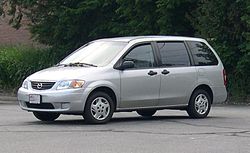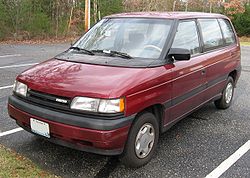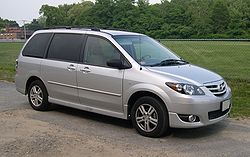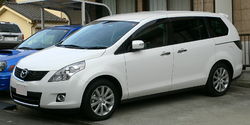- Mazda MPV
-
Mazda MPV 
Manufacturer Mazda Production 1989–present
1989–2006 (USA and Europe)Assembly Hiroshima, Japan
Taiwan USA Thailand (Russia)[1]Successor Mazda5 (For North America and Europe)
Mazda CX-9 (For North America and Australia)Class Minivan The Mazda MPV (Multi-Purpose Vehicle) is a minivan manufactured by Mazda. Introduced in 1989 as a rear-wheel drive model with optional selectable four-wheel drive, it was replaced in 2000 with a front-wheel drive-only version. Over one million MPV models had been produced since its introduction.[2]
Contents
First generation 1989-1999 (RWD/4WD)
First generation 
Also called Efini MPV (during 1991-1997 in Japan) Production 1989–1999 Body style 3-door van (1989-1995)
4-door van (1996-1998)Layout Front engine, rear-wheel drive / four-wheel drive Platform Mazda LV platform Engine 2.6 L G6 I4 (1989-1996)
2.5 L G5 I4 (1996-1999)
3.0 L JE V6Transmission 4-speed automatic
5-speed manualWheelbase 110.4 in (2,804 mm) Length 1989-1994: 175.8 in (4,465 mm)
1995-98: 183.5 in (4,661 mm)Width 71.9 in (1,826 mm)
1991-95 4WD: 72.3 in (1,836 mm)Height 1989-1992 & 1995-98 2WD: 68.1 in (1,730 mm)
1991-92 4WD: 70.8 in (1,798 mm)
1993-94: 66.7 in (1,694 mm)
1993-94 4WD: 69.4 in (1,763 mm)
1995-97 4WD: 70.8 in (1,798 mm)
1998 2WD: 68.9 in (1,750 mm)
1998 4WD: 71.5 in (1,816 mm)Related Mazda 929 The minivan boom of the 1980s caught the Japanese car makers by surprise. Each maker had its own response: Toyota was first with an adaptation of their mid-engined Van, based on the Japanese TownAce in 1984. Nissan and Mitsubishi quickly followed suit with conversions of cargo vans in 1987, but all of them were small and only offered four-cylinder engines which limited their popularity in North America.
The 1989 MPV was designed from the ground-up as a minivan specifically for the American market. It was based on the large rear wheel drive 929's HC. It would be called the LV platform, and equipped the MPV with a V6 engine and optional four-wheel drive. Its selectable 4WD system is not to be confused with permanent "all wheel drive" systems; the MPV can be switched into 4WD with a switch mounted on the column gear selector. A dash mounted switch also allowed the driver to lock the center differential, splitting power equally between the front and rear axles. The 4WD can be engaged and disengaged while moving.
Unlike other minivans, the MPV's parking brake was directly on the floor beside the driver's seat and operated by the hand, when most other minivans had the parking brake in the driver footwell area and operated by the left foot. Like the later Honda Odyssey introduced in North America starting in 1995, it featured traditional hinged doors instead of sliding rear doors, though the original MPV only had a single rear door. This was also the only Mazda MPV generation with a manual transmission. The middle row was available as a bench, allowing seating for eight when most minivans only seated seven. Because of the MPV's optional 4WD, the Mazda Navajo version of the Ford Explorer (sold from 1991 to 1994) was only offered as a two-door, so as to minimize internal competition.
The van was named to Car and Driver magazine's Ten Best list for 1990 and 1991 and featured as one of their "vehicles for the coming (fuel) crisis". Initial sales were strong as well, but rapidly fell off once other makers introduced all-wheel drive and V6 engines. In the years to come, Toyota's 1991 Previa, Nissan's 1993 Quest, and Honda's 1995 Odyssey had entered the market and began diluting Mazda's market share. Sales weren't helped when the MPV received one star out of four in the Australian Australasian New Car Assessment Program (ANCAP) crash tests and a "Marginal" rating in the American Insurance Institute for Highway Safety (IIHS) crash tests for damage to the occupant compartment and tire intrusion into the driver footwell area.
The van was refreshed in 1996, adding drivers' side rear door, airbag, and moving the parking brake to the footwell. While the four-cylinder engine was retired for the United States market, it was replaced with a similar but somewhat smaller 2.5 L unit for the rest of the world. The '97 and '98 models received a mild refreshing with "all-sport" body cladding and wheel arches, and polished alloy wheels. Mazda discontinued the original MPV after the '99 model year.
Second generation 1999-2006 (FWD/4WD)
Second generation 
Production 1999–2006 Body style 4-door van Layout FF layout Platform Mazda LW platform Engine 2.0 L FS-DE I4 (99-02)
2.3 L L3-VE I4 (02-05)
2.5 L GY-DE I4 (99-01)
2.5 L AJ V6 (99-02)
3.0 L AJ V6 (02-06)
2.0 L RF MZR common rail turbodieselTransmission 5-speed 5F31J automatic Wheelbase 111.8 in (2,840 mm) Length 1999-01: 187.0 in (4,750 mm)
2002-03: 187.8 in (4,770 mm)
2004-06: 189.5 in (4,813 mm)
2004-06 LX-SV: 189.3 in (4,808 mm)Width 72.1 in (1,831 mm) Height 68.7 in (1,745 mm)
2004-06 ES: 69.1 in (1,755 mm)Related Mazda 626
Ford Windstar
Kia CarnivalThe MPV was replaced in June 1999, using the short wheelbase, front wheel drive LW platform. It now featured dual sliding rear doors equipped with roll-down power windows and a third row seat that could fold and tumble into a floor recess. In the North American markets, the MPV was set apart from other minivans by its comparatively sporty chassis.[3]
At introduction, the MPV used the same 170-hp DOHC 2.5 L Ford Duratec V6 unit that powered the Ford Contour and Mercury Mystique and Cougar.[3] DX models featured a two-place middle bench seat. The LX model featured two middle buckets with a feature whereby the passenger side seat could slide sideways (marketed as "side by slide"), power windows and locks, heated power mirrors, privacy glass, and antilock brakes. The ES model added leather seating surfaces, wood tone interior trim, side impact air bags on the front seats, bigger wheels, and dual zone front and rear air conditioners.
In model year 2001, all models added child-safety seat tether anchors. An optional GFX sport appearance package was made available for LX and ES models, which included fog lights and aero body add-ons. The 2001 model year ran long, extending into early 2002 in anticipation of the 2002 refresh.
In model year 2002, the MPV received Mazda's AJ 3.0 L V6, a 5-speed automatic transmission producing 200 hp (149 kW) and 200 lb·ft (270 N·m) of torque, a new grille featuring a single chrome bar at the top, power sliding side doors, revised suspension settings, and 17-inch alloy wheels. In the Japanese and other markets, the 2.0 and 2.5-liter four-cylinders were replaced by the new 2.3 L L3-VE direct injection (DISI) inline four, as first seen in the all-new Mazda6. In Europe a 136 PS (100 kW), 2.0-liter "MZR" common-rail turbodiesel engine was also available.
In model year 2003, power operation of the side doors was made optional on the LX and ES. A base LX-SV model was added midway into the model year.
In model year 2004, the MPV received a mild exterior and interior makeover. The exterior featured new headlights and Altezza style clear taillights. Interior changes included a new steering wheel, gauge surrounds, and a spring assist to ease folding the third row seat into the floor. The LX Sport package added a customized look with alloy wheels, body side skirts, enhanced tail lights, anti-lock brakes, an air dam under the bumper, and an optional rear-mounted spoiler. The ES model added leather seats, rear air conditioner, power sliding doors, and a choice of moonroof or roof-mounted DVD player. No LX-SV model was offered.
In model year 2005, dual zone air conditioning became an optional feature on the LX (it had been standard on the LX in 2004).
In model year 2006, a base LX-SV model was again offered alongside the LX and ES models.
The MPV was discontinued in both Europe and North America after model year 2006. The MPV was also replaced in North America and Australia by the full-size Mazda CX-9 crossover SUV. Australian models were available with 3 seats in the 2nd row, and two seats in the 3rd row instead of a folding third row.
Engines:
- 1999-2002 2.0 L FS-DE I4 (non-US)
- 1999-2001 2.5 L GY-DE I4 (non-US)
- 1999-2002 2.5 L AJ V6
- 2002-2006 3.0 L AJ V6
- 2002–2005 2.3 L MZR 2.3 Direct Injecition Spark Ignition (DISI) I4 (non-US)
- 2002–2005 2.3 L MZR RF common rail turbodiesel I4 (Europe)
For 2006 the base MSRP for MPV models was LX-SV ($22,115), LX:(22,950), and ES ($28,515).
The Mazda MPV earned an "Acceptable" rating in the IIHS offset frontal crash test in 2000 for fair structural performance and very high forces on the dummy's right foot. In 2005, it earned a "Poor" rating in the side-impact crash test without the optional side airbags, indicating that high injuries to the driver and rear occupant are possible.
Third generation 2006-Present (FWD/4WD)
Third generation (Asia-Pacific) 
Also called Mazda8 Production 2006–present Body style 4-door van Layout FF layout Platform Mazda LY platform Engine 2.3 L L3-VE I4
2.3 L L3-VDT turbo I4Transmission 4/5/6-speed automatic Wheelbase 2,950 mm (116.1 in) Length 2007: 4,868 mm (191.7 in)
2008-present: 4,860 mm (191.3 in)Width 1,850 mm (72.8 in) Height 1,685 mm (66.3 in) Related Mazda6 On February 2, 2006, the third generation Mazda MPV went on sale in Japan.[4] It is powered by either a four cylinder MZR Direct Injection Spark Ignition (DISI) 2.3-litre naturally aspirated engine or the turbo version of the same. The second row reclining seats feature an unusual retracting footrest feature. The gear shift was moved from the steering column to the center console, much like most other minivans by Japanese automakers today.
The third generation MPV is currently available only in Japan, Hong Kong, Macau, Indonesia, Thailand and Malaysia.[5] It is known as Mazda8 in Hong Kong, Macau, and Malaysia. The 4WD and Turbo models are available only in the domestic (Japanese) market, while all export models (usually known as Mazda8) are naturally aspirated FWD models only. It is not exported to North America; instead the Mazda CX9 is offered there.
In 2008, a facelifted version was introduced. External modifications include a new front bumper with new foglights. A five-speed automatic transaxle replaced the four-speed unit used in NA FWD models. Six-speed Automatics remained in the turbo and 4WD models.
Turbo models were discontinued in 2010. A Malaysian version was introduced in 2010, the fourth market in which the third generation Mazda MPV is sold.
References
- ^ "Facilities | Ford Motor Company Newsroom". Media.ford.com. http://media.ford.com/plant_display.cfm?plant_id=129. Retrieved 2010-07-27.
- ^ "Mazda MPV Production Reaches One Million Units". Webwire.com. http://www.webwire.com/ViewPressRel.asp?aId=10177. Retrieved 2009-04-11.
- ^ a b Chase, Chris (January 2010). "Used Vehicle Review: Mazda MPV, 2000-2006". Canadian Driver. http://www.canadiandriver.com/2010/01/21/used-vehicle-review-mazda-mpv-2000-2006-2.htm.
- ^ "The innovative Mazda MPV minivan is a "next-generation people mover" with the soul of a sports car". Mazda Press Release. http://mazdanews.com/node/view/263. Retrieved June 4, 2007.
- ^ "to Sell New MPV in Hong Kong | News Releases". MAZDA. 2006-03-22. http://www.mazda.com/publicity/release/2006/200603/060322a.html. Retrieved 2009-04-11.
External links
- YahooAutos-2006 Mazda MPV
- AutomobileMagazine-2005 Mazda MPV (review)
- MPV Club
- Mazda announces 1 million built, introduces gen3 and planned turbo version for Japan
« previous — Mazda road car timeline, 1990s–present Type 1990s 2000s 2010s 0 1 2 3 4 5 6 7 8 9 0 1 2 3 4 5 6 7 8 9 0 1 Kei car Carol Carol Carol Carol Carol AZ-Wagon AZ-Wagon AZ-Wagon AZ-Wagon AZ-Offroad Spiano Scrum Scrum/Scrum Wagon Scrum/Scrum Wagon Subcompact Revue/121 Demio/121 Demio/Mazda2 Demio/Mazda2 Verisa Compact Familia/323/Protegé Familia/323/Protegé Familia/323/Protegé Axela/Mazda3 Axela/Mazda3 Familia Van Familia Van Familia Van Mid-size Capella/626 Capella Capella/626 Atenza/Mazda6 Atenza/Mazda6 Cronos/626/Xedos 6/Eunos 500 Eunos 800/Xedos 9/Millenia Mazda6 (N.America) Full-size Sentia/929/Efini MS-8 Sentia Sports car AZ-1 MX-3 Precidia Roadster/MX-5/Miata Roadster/MX-5/Miata Roadster/MX-5 MX-6/Mystère MX-6/Mystère/Efini MS-6 RX-7 Efini RX-7/RX-7 RX-8 Cosmo Minivan Premacy Premacy/Mazda5 Premacy/
Mazda5Bongo Friendee Biante Efini MPV/MPV MPV MPV/Mazda8 Crossover CX-7 CX-9 SUV Navajo Tribute Tribute Pickup B-Series B-Series B-Series BT-50 BT-50 Van Bongo Bongo Mazda automobile timeline, North American market, 1980s–present Type 1980s 1990s 2000s 2010s Model year 0 1 2 3 4 5 6 7 8 9 0 1 2 3 4 5 6 7 8 9 0 1 2 3 4 5 6 7 8 9 0 1 Subcompact GLC GLC Mazda2 323 323/Protegé Compact Protegé Protegé Mazda3 Mazda3 626 626 626 Mid-size 626 626 Mazda6 Mazda6 Millenia Full-size 929 929 Sport compact MX-3 MX-6 MX-6 Sports MX-5 Miata MX-5 Miata MX-5 RX-7 RX-7 RX-7 RX-8 Minivan Mazda5 MPV MPV Mid-size crossover CX-7 Full-size crossover CX-9 SUV Navajo Tribute Tribute Pickup B-Series B-Series B-Series B-Series Categories:- Mazda vehicles
- Minivans
- All wheel drive vehicles
- Front wheel drive vehicles
- Rear wheel drive vehicles
- 1980s automobiles
- 1990s automobiles
- 2000s automobiles
- Vehicles introduced in 1989
Wikimedia Foundation. 2010.







